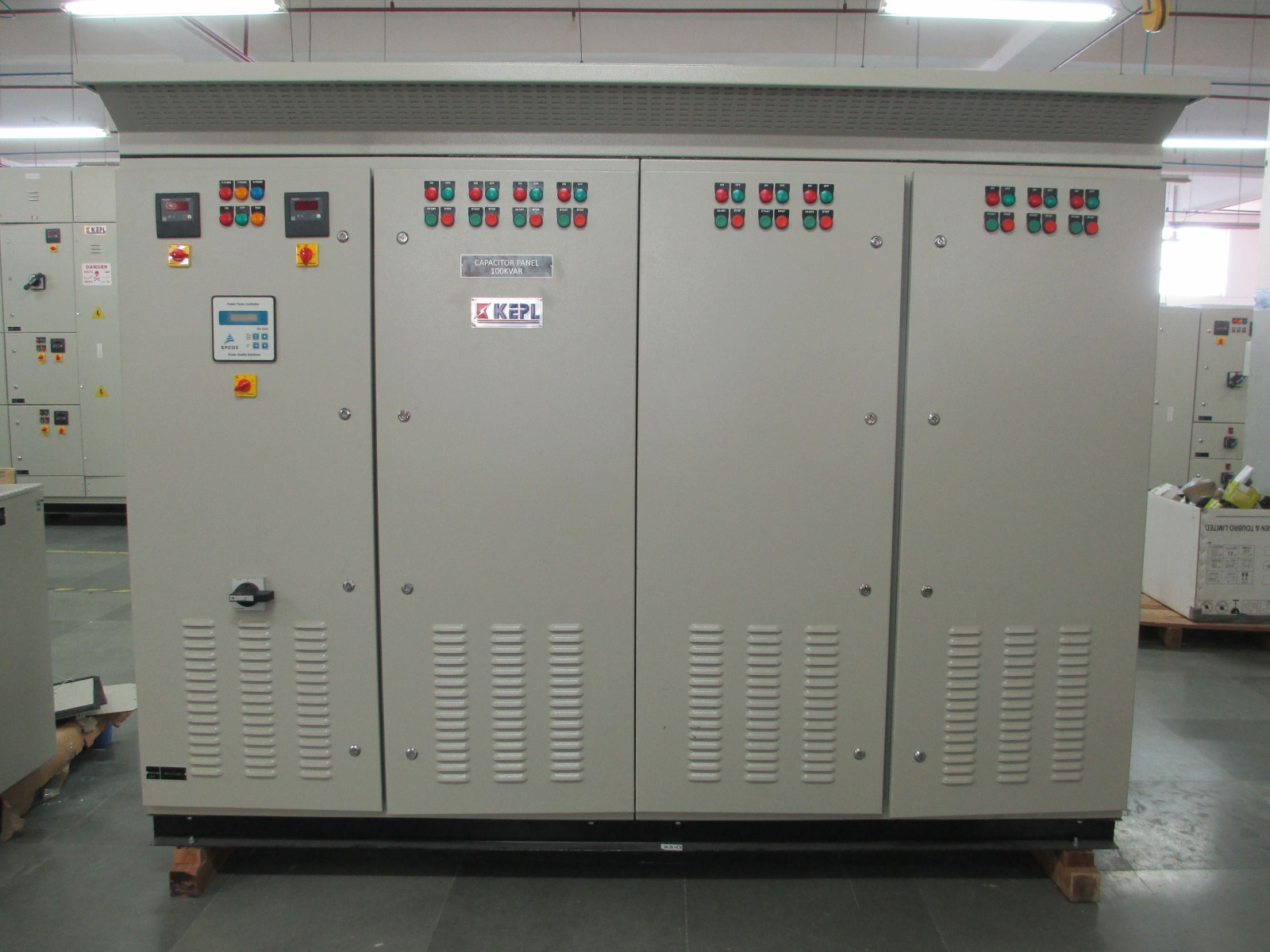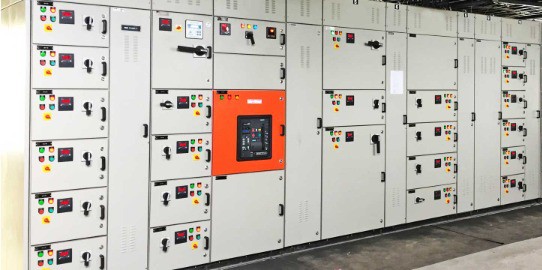Understanding IEC:61439 and Approach Toward its Conformity
The low voltage switchgears can be described as a combination of several components such as circuit breakers, lightning arrestors, current transformers, protection panels, and disconnections. They are used to effectively control and distribute electric power across residential, commercial, and industrial premises to prevent electrical circuits and equipment from unregulated power thwarts.
A simple description like above does not usually provoke us enough to ponder much while specifying or say while procuring a Low voltage switchgear Assembly.
But we must admit here that the wizards of power distribution design take at most care in designing the ratings of the several components to the perfection with their unparalleled expertise.
However, few aspects that get ignored for various reasons are brought out here and forms the basis of this article. Here we wish to focus on safety, greater safety, and yes highest possible safety!! The reason being straight and simple – No compromise what so ever when a human life is at stake! Yes, a workplace like a medium voltage substation or a low voltage substation with LV and MV switchgear is undeniably a high-risk work environment; even more for personnel directly involved in operation and Maintenance of these equipment and it becomes the onus on the designer / specifier and the procurer /user to ensure in providing not the minimum but the maximum safety possible.
Understandably a good design would to an extent ensure this but not completely. However, we would not get into design aspects here, rather the focus shall be from the point of view of compliance to IEC and BIS standards.
At the same time, we shall also focus here on the verification of compliance to standards. Reliability & availability of power form the other two vertices of an iron triangle (just a conceptual representation) with safety forming the third as well as the pinnacle of the iron triangle.
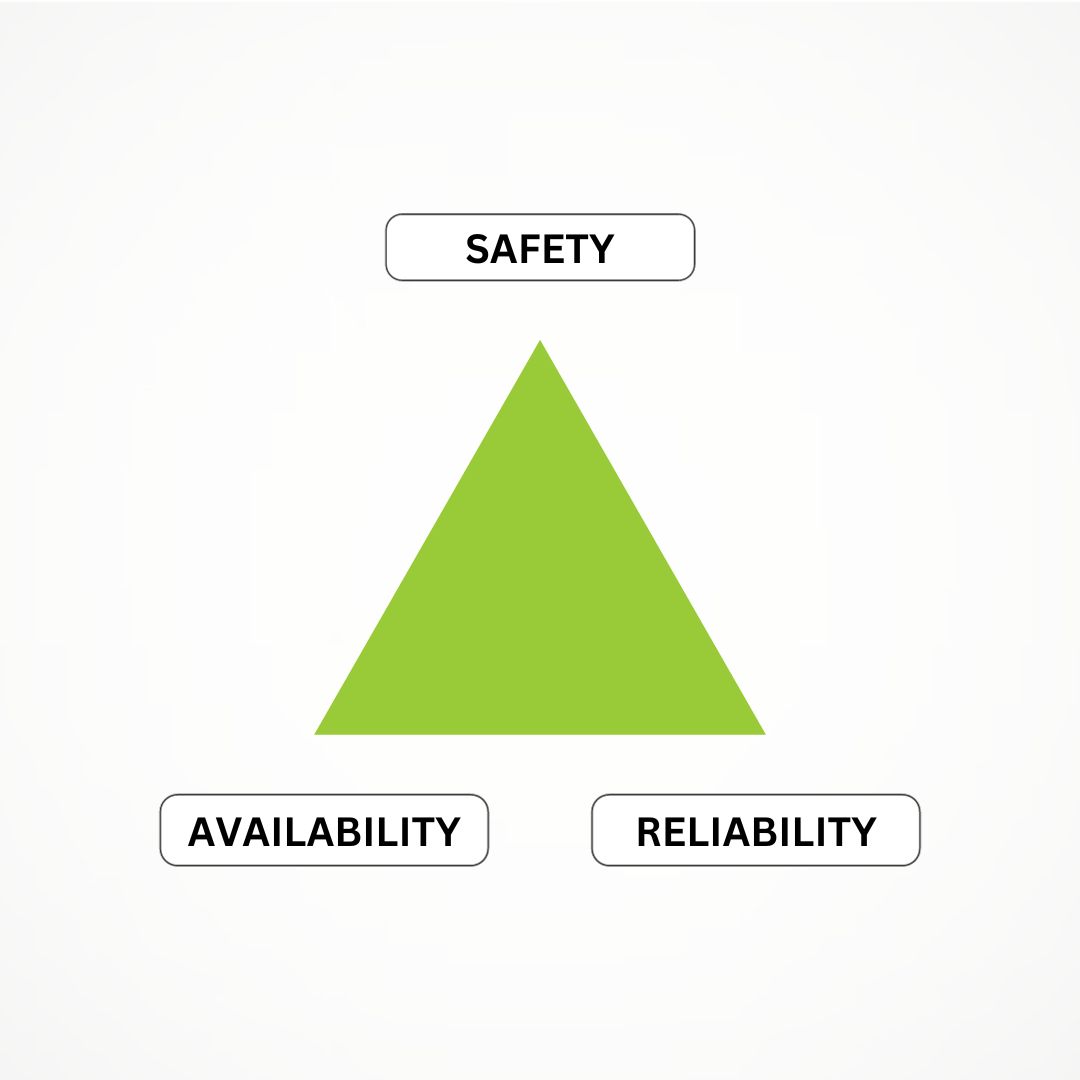
Before one starts to think why safety, compliance to standards, verification of compliance to standards is being discussed exclusively in the context of Low voltage Switchgear, the answer is simple:-
- Low voltage switchgear dominated the overall India Switchgear market and reflects the highest growth due to rapidly growing commercial and residential sectors. Hence it becomes obvious that we ensure high safety and reliability standards with this equipment that is dominating the market share and market growth.
- Secondly Human intervention in terms of operation & maintenance activities is more when it comes to LT switchgear making them a high-risk area for electrical accidents when non standardized panels are being used.
Standards that are often used when it comes to Low voltage assemblies are IS 8623, IEC 60439 part 1, IEC 61439 part 1 &2 and the lesser-known IEC/TR 61641. Though all the Standards are not mandatory but voluntary (mandatory standards are those few which are part of a country’s legislation) However, this should not be an excuse to compromise on safety. Clearly the onus is on the designers, manufacturers, and end users.
Also, installation owners seldom evaluate the cost of a downtime. General perception among the purchasers & specifiers is that complying to standards is an upfront cost. This perception is wrong. Ensuring higher safety standards is saving a human life and cannot be perceived as a cost. Products complying to standards and that are certified shall guarantee a lower process or operational downtime improving there by reliability and availability.
This contributes to a lower TCO or a lower life cycle cost. With the above content clear in our minds and with the hope that the message being conveyed is correctly received, we will proceed to how safety, reliability, and availability aspects in the context of a LV assembly / panels is met by compliance to the relevant standard IEC 61439 which IEC defines for Low voltage switchgear and control gear assemblies.
We will also see how verification to compliance with IEC 61439 is carried out through the conformity assessment approach adopted by IEC.
IEC 61439 Part 1 & 2 is that standard that supersedes the withdrawn standards IS 8623 and IEC 60439. If we recall, IEC 60439 part 1 and IS 8623 part 1 defines the terms” Partially type tested” and “Totally type tested panels”. With the mention of these terms, it is very difficult for a user as well as Specifier to exactly verify whether the standards are being correctly complied with by the Low voltage assemblies that are being manufactured, specified, and used by the manufacturers, consultants, and end users respectively.
IEC 61439 ensures that the switchboards are “design verified” for 12 different types of tests when compared to IEC 8623 or IEC 60439 which ensures just 6 or 7 type tests there by leaving a gap or a compromise on the three important aspects of the iron triangle described above. The below table throws some light on the gaps of IEC 60439 / IS 8623 as against IEC 61439.
| S.No | Description | IS 8623 | IEC 60439 | IEC 61439 |
|---|---|---|---|---|
| 1 | Strength of materials | |||
| a | Resistance to corrosion-severity A | |||
| b | Properties of insulating materials: | |||
| b1 Thermal stability | ||||
| b2 Resistance of insulating material to normal heat | ||||
| b3 Resistance to abnormal heat and fire due to internal electrical effects | ||||
| c | Resistance to ultra-violet (UV) radiation | |||
| d | Lifting | |||
| e | Mechanical impact | |||
| f | Marking | |||
| 2 | Degree of protection of enclosure (IP) | |||
| 3 | Clearance and creepage distances | |||
| 4 | Protection against electric shock and integrity of protective circuits: | |||
| a | Effective continuity between the exposed conductive parts of assembly and protective circult |
|||
| b | Effectiveness of assembly for external faults | |||
| 5 | Incorporation of switching devices and components | |||
| 6 | Internal electrical circuits and connections | |||
| 7 | Terminals for external conducters | |||
| 8 | Di-electric properties: | |||
| a | Power frequency withstand voltage | |||
| b | Impulse withstand voltage | |||
| 9 | Temperature Rise limits | |||
| 10 | Short circuit withstand strength | |||
| 11 | Electromagnetic compatibility (EMC) | |||
| 12 | Mechanical operations |
If we observe in the above table the important tests or say the design features that are infused in IEC 61439 when compared to IS 8623 and IEC 60439 are strength of materials, dielectric properties by measuring the impulse withstand, behaviour of the assembly in the presence of switching devises & other components and finally the impact of EMC in an LV assembly.
The most important point to be mentioned here is, as per IEC 61439 part 1 & 2, the conformity or verification of
- strength of materials and dielectric properties measurement is acceptable through testing only and not by other two options of verification allowed in IEC 61439 part 1 &2 namely verification through reference design and verification through assessment or calculation. Needless to explain these tests ensure Assemblies shall be manufactured of materials capable of withstanding the mechanical, electrical, thermal, and environmental stresses directly contributing to reliability and safety aspects. IEC 61439 makes a direct reference of IEC 62208 and Vice versa. IEC 62208 is – General requirements- Empty enclosures for low-voltage switchgear and control gear assemblies
- The most important and distinguishing tests/ design verifications brought into IEC 61439 part 1 &2 are the tests / design considerations for incorporation of switching devices and components; Internal electrical connections and circuits and lastly terminals for external conductors. What is so differentiating or distinguishing aspect with these three design considerations? These design considerations are verified only through calculation & assessment and not by testing as per the standard. Which means the assembly manufacturer who might not be compulsorily a switching device manufacturer and other components manufacturer that s switchboard comprises of shall not have a 100% control as he has to rely and coordinate with the manufacturer whose switching devices and components the assembly manufacturer might use to get his assembly 61439 certified. To elaborate this a bit more the kinds of verifications which are part of these tests are
- Switching devices and other components installed in an assembly are compliant with relevant standards (e.g., BS EN 60947 Series).
- Short circuit protective devices used in the assembly will not be subjected to short circuit stresses beyond their capability.
- The installation and connection of switching devices and other components are carried out in accordance with manufacturer’s instructions and in such a way that in normal service, their interaction with other installed devices does not impair their required performance in the assembly.
- the physical positioning of certain external accessible switching elements, controls, indicators etc. must be within defined height limits.
- Co-ordination between switching devices and for example motor starters with protective devices
- Installation & wiring of switching devices and components in a manner such that their functioning is not impaired by interaction such as heat, switching emissions, vibrations etc.
- Accessibility of functional units, handles and pushbuttons for ensuring easy operation and maintenance activities
- Internal circuits are to be so ensured that bus bars arrangements shall mitigate internal short-circuits, bus bar ratings such that they can withstand stresses due to short circuits
- Ensuring auxiliary circuits are protected during short circuit conditions
- Connections of current carrying parts do not suffer undue alterations for reasons like ageing of insulation, temperature rise and vibrations
If we closely review the above points, we can clearly understand the significant role and level of expertise needed from a switching device and component manufacturer in making the LV assembly comply to the IEC 61439 standard. A relatively strong argument that could be made from these points is the best design of LV assembly complying to IEC 61439 is achieved if the assembly manufacturer is a switching device and other components manufacturer as well.
Hence we would be not wrong in entirety if we wish to state that, a switching device and component manufacturer makes the LV assembly which is more reliable and compliant to IEC 61439 standard .Impulse withstand to verify dielectric properties & verification of immunity to Electromagnetic compatibility through design rules or testing is mentioned in IEC 61439 which were otherwise missing in the old standard .
While we have addressed above how three aspects of Safety, Availability and reliability have been take care of in the new IEC 61439, for more understanding of the new standard we will mention few generic points of differentiation between the two standards.
1. Alteration in the content of two standards.
| Content of IEC 60439 | Content of IEC 61439 |
|---|---|
| 1. General (scope + norm. Ref.) | 1. Scope |
| 2. Normative references | |
| 2. Definition | 3. Definitions |
| 4. Symbols and abbreviations | |
| 3. Classifications | moved to clause 5.5 |
| 4. Characteristics | 5. Characteristics |
| 5. Information | 6. Information |
| 6. Service conditions | 7. Service conditions |
| 7. Design and construction | 8. Constructional requirements |
| 9. Performance requirements | |
| 8. Test specifications (inc.routine tests) |
10. Design verification |
| 11. Routine verification |
2. Several new definitions are introduced in IEC 61439
There are three definitions involving verification: design verification: referring to an assembly or part of an assembly; verification test: referred to in case where verification involves a test; and verification assessment: referring to those verifications that were done based on calculations and/or design rules.
The new standard distinguishes the original manufacturer and the assembly manufacturer. This enables to make distinct responsibilities for both parties. The original manufacturer bears design responsibility; therefore, he has to implement the constructional design rules and carry out the verification. The assembly manufacturer may be a completely other company, he is expected to follow the instructions of the original manufacturer assembling the switchgear and carry out the routine tests.
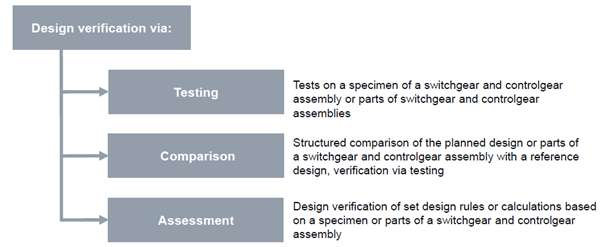
| Property requiring verification | Verification | options | |
| Testing | Comparison | Assessment | |
| Strength of materials | YES | NO | NO 1.) |
| Degree of protection of the enclosure | YES | NO | YES |
| Clearances | YES | NO | NO |
| Creepage distances | YES | NO | NO |
| Protection against electric shock and integrity of protective circuits | YES | NO 2.) | NO |
| Incorporation of switching devices and components | NO | NO | YES |
| Internal electrical circuits and connections | NO | NO | YES |
| Terminals for external conductors | NO | NO | YES |
| Dielectric properties | YES | NO | NO 3.) |
| Temperature rise limits | YES | YES | YES |
| Short-circuit withstand strength | YES | YES | NO |
| Electromagnetic compatibility (EMC) | YES | NO | YES |
| Mechanical function | YES | NO | NO |
Few more additions in terms of addressing device substitution, Rated diversity factor, Mandatory declaration, and confirmation of an impulse rating, not just insulation resistance measurement but also power frequency withstand as means of confirming dielectric performance.
Verification approaches to short circuit withstand and temperature rise have also been clarified. The detailed explanation of such changes could be addressed in a separate document and is not considered here for discussion.
In the simplest possible way, we can say that the 61439 standard ensures far lesser possibility of a short circuit or an arc arising due to an electrical fault. The standard evolved with the consideration of mitigating all the possibilities that could lead to a fire accident arising due to a poorer design and construction of an LT electrical switchboard.
With the above explanation, one must have got a fair idea on how IEC 61439 part 1 &2 enhances the safety, reliability, and availability aspects as compared to the withdrawn standards IS 8623 and IEC 60439 part 1. we can now proceed to understand how does one ascertain that the switchboard he is wishes to procure as an end user or say how does a specifier ascertain that the switchboard, he is specifying for the end user shall be fully compliant with this little complex requirements of IEC 61439 Part 1& 2.
IEC has taken enough care in addressing such challenges for the specifiers and the users by defining the IEC/Iso 17000 series which explains well the conformity assessment standards that IEC promotes/ defines.
Through the two standards of IEC/ISO 17025 and IEC 17065, it differentiates between the conformity assessment requirements of a testing & calibration laboratories and certification
Bodies; meaning the conformity of IEC 61439 part 1&2 assembly can be verified by asking for the relevant certificate from an IEC /ISO 17065 compliant certification body and not by a test report from a testing and calibration laboratory.
A little detailed understanding is a must about the conformity assessment standards followed by IEC as they guide us on verification of compliances to various standards which the product manufacturers may claim.
Conformity assessment allows to determine if a product or service is what it appears to be and if a system performs as it should. It provides insights into safety, quality, efficiency, effectiveness, the economic use of materials and energy, if a product fits and operates correctly with other products, and its effect upon the environment (pollution, noise).
- Governments want to protect their populations from unnecessary risks.
- Insurers want to know that equipment will not cause loss of life or damage.
- Buyers want proof about a product’s or system’s safety, performance, and reliability.
- Users of equipment and consumers want to be able to trust the product or service they are purchasing.
There are basically three types of CA which is supported by IEC.
- 1st party CA where the manufacturer himself declares that he is conforming to the standard. This is ok for products which do not cause any danger to human life / property which means this applies to low-risk products.
- 2nd party CA where a purchaser typically governments shall put their own criteria for assessment and is not so common.
- 3rd Party CA is performed by a person or body that is independent of the seller and the buyer. It is usually called certification and provides the highest level of confidence. Certification is an independently-provided unbiased assurance of the safety of products and processes. This CA is applied where a major market makes it cost-effective or where it is mandated by legislation. Since CBs (Certification Bodies) are usually for-profit companies it is also more expensive than first-party CA.
While the IEC supports all three forms of CA, the IEC CA Systems are based on 3rd-party CA. They provide independent testing and certification to ensure the safety, reliability and performance of products and systems.
The CAB (Conformity Assessment Board), an integral policy-making part of IEC, is responsible for the overall management of IEC conformity assessment policy and operations, including risk management and governance of the Systems. CAB also Liaisons with ISO/CASCO on the development and approval of joint ISO/IEC standards on conformity assessment.
Promoting and maintaining relations with international, regional, and national organizations on CA matters – ISO/CASCO, ILAC and IAF
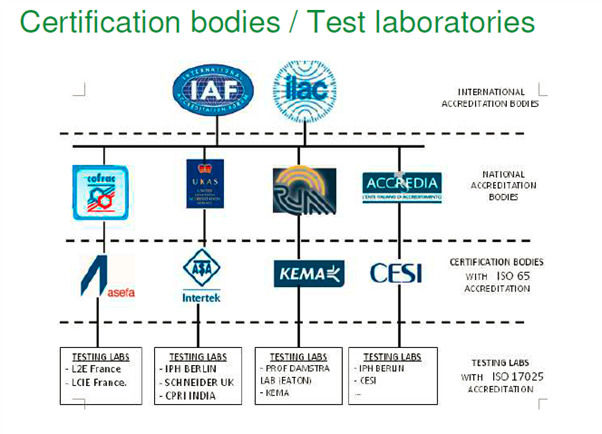
Among the 30 plus standards mentioned in ISO/IEC 17000 series, three standards that are most relevant to the discussion here and magnifies the objective of this article, are as below.
ISO/ IEC 17025: 2017 -General requirements for the competence of testing and calibration laboratories
ISO/IEC 17065: 2012 -Conformity assessment — Requirements for bodies certifying products, processes, and services.
ISO/IEC 17067: 2013 Conformity assessment — Fundamentals of product certification and guidelines for product certification schemes
An excerpt from the above standards, especially the scope part in the standards gives a good insight what each standard is about.
ISO/ IEC 17025: 2017 “This document specifies the general requirements for the competence, impartiality, and consistent operation of laboratories. This document is applicable to all organizations performing laboratory activities, regardless of the number of personnel. Laboratory customers, regulatory authorities, organizations, and schemes using peer-assessment, accreditation bodies, and others use this document in confirming or recognizing the competence of laboratories.”
ISO/IEC 17065: 2012 “This International Standard contains requirements for the competence, consistent operation and impartiality of product, process, and service certification bodies. Certification bodies operating to this International Standard need not offer all types of products, processes, and services certification. Certification of products, processes and services is a third-party conformity assessment activity (see ISO/IEC 17000:2004, definition 5.5).”
Going a step further looking into the “process requirements “of each standard ISO/IEC 17025 & ISO/IEC 17065 will reveal how these two standards differ or in simple terms how a certification body is different from a test laboratory. In addition to this, it becomes clearer how a test report which is nothing but a test result or a calibration certificate.
A look at the “process requirement “of Iso/IEC 17065 further showcases a more elaborate, methodical approach to issuing a certificate to any product. This includes application receiving, application review, evaluation, evaluation review and finally decision on certification. Most importantly it is ensured that in all these stages different personnel with required skill set are engaged.
The details that are captured in the application are plenty like
- the product(s) to be certified
- the standards and/or other normative documents for which the client is seeking certification
- the general features of the client, including its name and the address(es) of its physical location(s), significant aspects of its process and operations (if required by the relevant certification scheme), and any relevant legal obligations;
- general information concerning the client, relevant to the field of certification for which the application is made, such as the client’s activities, its human and technical resources, including laboratories and/or inspection facilities, and its functions and relationship in a larger corporation, if any;
- information concerning all outsourced processes used by the client that will affect conformity to requirements; if the client has identified a legal entity/entities for producing the certified product(s) that is different from the client, then the certification body can establish appropriate contractual controls over the legal entity/entities concerned, if necessary for effective surveillance; if such contractual controls are needed, they can be established prior to providing formal certification documentation
- all other information needed in accordance with the relevant certification requirements, such as information for initial evaluation and surveillance activities, e.g., the locations where the certified product(s) are produced and contact personnel at these locations.
One of the key aspects of IEC/ISO 17065 is surveillance which offers continuing assurance on conformity. Of the various schemes of certification if the scheme with surveillance is considered then the certifying body shall do the necessary surveillance activity as per the certification scheme employed by the manufacturer. the below extract from the standard is for understanding and clarity. A careful read through the below extract from the standard is a must to appreciate the differentiation between a testing activity and a certification activity. In addition, this will also enable the reader to as to why a product should be certified for ensuring conformity to a particular standard.
A simple example that could be cited here straight away; is a lot of panel builders or assembly manufacturers claim to have IEC 61439-part 2 compliant LT switchboard. Even claim is made that the Switchboard is totally type tested. The approach sometimes taken by these panel builders is advocating the clients or the buyers to go for a partial Type tested panel with a vague justification that partial type tested panel/60439 Part 1 will suffice the buyer’s requirement or an even more insensitive justification that 61439 part 1 &2 compliant panels are costly etc…
Hope after understanding the facts and explanations made in this document the buyers as well as specifiers would readily counter such justifications with the following statements.
- IS 8623 / IEC 60439 have been withdrawn. Primarily because this standard lacked in many aspects.
- Terms like Partially type tested, fully type tested concepts are not relevant anymore and only the term “design verified assembly “is relevant.
- If the claim made by the panel builder/ manufacturer of having an IEC 61439 part 1 &2 compliant switchboard could be verified by a certificate from an IEC 17065 compliant certification body instead of a 17025 compliant testing & calibration laboratory like CPRI, ERDA etc.
- If an IEC 61439 part 1 &2 compliant panel is costly, is that cost more than a human life (of the personnel working in the premises of the LT switchboard)?
- Lastly how reliable is the LT switchboard in terms of managing and guaranteeing a minimal downtime.
With such intriguing counter questions, a buyer/ specifier is ensuring a safe, reliable, and available LT switchboard.
Before concluding this article in totality, it becomes compulsory to briefly touch upon the standard which is slowly evolving as flagbearer of Personnel/operator safety working in the premise of an LT switchboard. This standard is none other than IEC / TR 61641. This standard purely ensures people and Personnel Safety and ensuring that an internal arc tested panel is procured is testimony by any installation owner that he cares for the personnel / employees / people operating it. The associated concepts with internal arc are the arc flash event, arc flash energy and the arc flash boundary. It can be understood that the above terms directly relate to time (event), energy and to the extent (boundary, distance of the personnel from the panel) of damage. These terms in principle define the seriousness of the impact and extent of damage an internal arc or an arc flash can do on the personnel / property in the surroundings. Understanding these in more detail is beyond the scope of this article but things to remember are as below.
- Internal Arc is different from Short-circuit by nature. In simple terms arc is a high impedance fault. The longer the arc the higher the energy in the event of flash and higher the damage.
- Internal Arc withstand value of any panel can be defined and should be defined while specifying. The values typically are X KA/ Y sec (x can typically range from 50 KA to 100 KA and Y can vary from 0.1 sec to 0.5 sec).
Hope this article brings about a change, much desired, in the mindsets of manufacturers, Specifiers and most importantly buyers. Safety, reliability, and availability matters the most to them and should be their top most priorities while procuring any electrical equipment and specifically in this context the LT Switchboard assembly.





